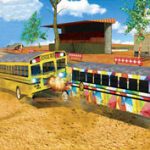MEXICAN DAZE – Part One
By Iris Slocombe
My husband Bert and I left England in February 1960, with ten other young people. Each of us had been accepted as members of the Wycliffe Bible Translators, also known as the Instituto Linguistico de Verano en Mexico, a Christian mission with the mission of translating the New Testament and other useful pamphlets, such as Health Primers into primitive languages which had not yet even been reduced to writing. Before leaving, we were each given a list of the required ‘jungle’ equipment which we could buy in the United Kingdom at most local ‘Army Surplus’ stores. There were ten of us Brits travelling together to Mexico, for the first part of our very necessary 65 months of jungle training.
Bert and I had been married almost twelve years. During his WWII years in Europe and India, Bert strongly felt he wanted to become a Christian missionary. I was not so keen because of my experiences as a child. My father, who was a physician, and the medical director of a Mission for poor people in East London, had to endure a life-long struggle to survive and maintain his family on a paltry stipend, even after giving the mission 50 years service!
Mexico was a very different kind of world. At that time many stretches of the Pan-American Highway were only partially paved and bumpy travel by bus was not what we were accustomed to. We had traveled to the U.S. on the United States liner from Southampton to New York. And then on to Laredo by Greyhound bus, but the change of bus on entering Mexico was quite an experience. After negotiating Inmigracion we were transferred to a ‘first class’(?) bus to Mexico City.
Inmigracion proved to be a challenge. The official was disconcerted when faced by our group! All ten of us were lugging identical duffles, stuffed with the basic necessities required for our six months experience of living in the Mexican jungle. Each of us had an air mattress, a sleeping bag made of lightweight blue Dacron plus ‘jungle hammocks,” machetes, and insect repellent, mosquito nets, a mess kit, and a few personal items. Obviously all those identical bags seemed suspicious to him, and after clearing nine of us the official had had enough! The last of our group was told to open his duffle and take everything out. One man had bad luck when punching the Custom light! The official rummaged through everything and was frustrated on finding nothing contraband. The fact that the rest of us were laughing convinced him that he must have missed something! Finally he gave up and told the man he could repack his duffle. The Mexican bus was supposed to be ‘first’ class,’ but the seats were barely upholstered, with wafer-thin plaid vinyl ‘cushions.’ The windshield was covered with pictures of saints, Guadalupe, and other Mexican favorite ‘santos,’ topped by a thick, red velvet fringe. Our driver barely squeezed past long lines of loaded donkeys and mules. We saw men staggering under heavy bundles dangling from their foreheads supported by hemp lines. It was anyone’s guess if the driver could even see the road at all past his windshield religious art gallery!
So, my husband Bert and I first travelled to Mexico from our native United Kingdom, as new members of an unusual missionary society, serving primitive locations where the indigenous people rarely spoke the national language, but speak languages never studied or even reduced to writing. Even though we were Registered nurses, we knew we would have to spend months, or even years, learning about the structure of languages.
To meet these requirements we attended linguistic courses in London and at The University of Oklahoma to be able to meet those requirements. For my Master’s Thesis, I studied Potawatomi, an American indigenous language, while Bert studied Kiowa, another ‘native American ‘ language.
Jungle training included many new experiences, learning to build homes for ourselves using nothing but jungle materials, building ‘mud’ stoves, and learning to prepare simple meals from the foods available, mostly bought from native villages. We also had to learn a little about butchering, the men who already were hunters really enjoyed this and also we were taught how to follow a faint trail through the jungle. We were given books about survival techniques, similar to those given to the troops in Viet Nam, and the care and use of our machetes, our only tool.
To Be Continued
(Ed. Note: For many years, Iris Slocombe was the pastor of the Anglican Church in Riberas de Pilar.)
- April 2024 – Issue - March 31, 2024
- April 2024 – Articles - March 31, 2024
- April 2024 - March 31, 2024










